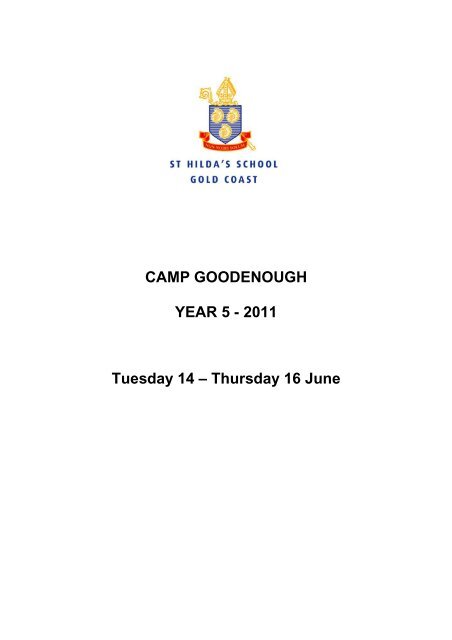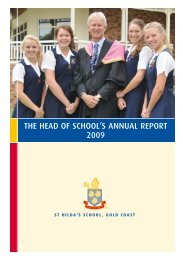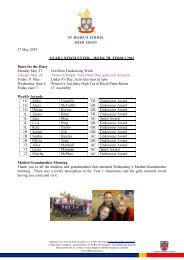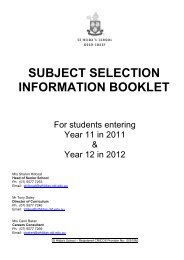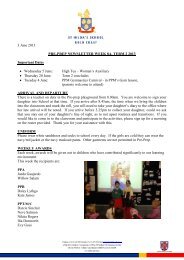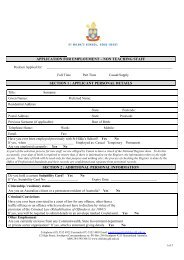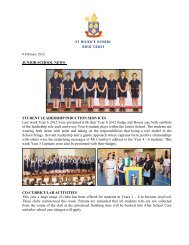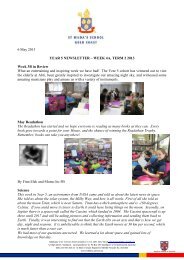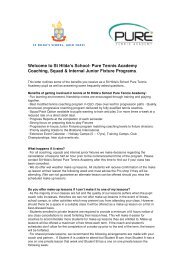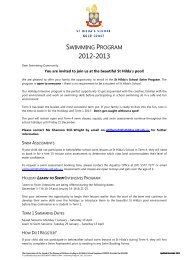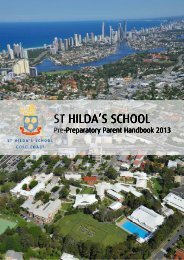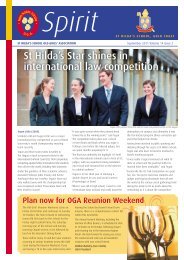CAMP GOODENOUGH YEAR 5 - 2011 Tuesday ... - St Hildas School
CAMP GOODENOUGH YEAR 5 - 2011 Tuesday ... - St Hildas School
CAMP GOODENOUGH YEAR 5 - 2011 Tuesday ... - St Hildas School
Create successful ePaper yourself
Turn your PDF publications into a flip-book with our unique Google optimized e-Paper software.
<strong>CAMP</strong> <strong>GOODENOUGH</strong><br />
<strong>YEAR</strong> 5 - <strong>2011</strong><br />
<strong>Tuesday</strong> 14 – Thursday 16 June
Location<br />
„Camp Goodenough‟ is an Outdoor Adventure and Education Centre located at Bilambil in the Tweed<br />
Valley. Situated in part of the Mt Warning Caldera, the property is hilly with a mixture of naturally<br />
regenerating rainforest and magnificent views. „Camp Goodenough‟ is located 15mins from Tweed<br />
Heads. The address of the campsite is 253 Carool Rd, Bilambil, NSW. Phone: 5590 9614<br />
Aims<br />
The Year 5 camp aims to:<br />
Inspire self-confidence and a positive attitude.<br />
<br />
<br />
<br />
<br />
<br />
<br />
<br />
Improve communication.<br />
Build Self-esteem.<br />
Improve leadership skills.<br />
Provide insight on how to be a more effective team member.<br />
<strong>St</strong>rengthen trust and co-operation.<br />
Develop respect for individuals‟ differences.<br />
Provide the students with an opportunity to experience Outdoor Education.<br />
<br />
Help students and staff to get to know each other and to develop a sense of belonging and<br />
community.<br />
Mrs Vail will be the teacher in charge of the camp accompanied by the Year 5 Form Teachers, Mrs<br />
Grimmer, Ms Power, House staff and other <strong>St</strong> Hilda‟s staff.<br />
A leadership program has been organised where everyone participates as an individual and as a<br />
member of a group. <strong>St</strong>aff, employed by Camp Goodenough, will be conducting the activities during the<br />
day. These activities, in which everyone will be involved, could include Abseiling, Flying Fox,<br />
Bushwalking, Environmental Awareness, Etriers, High Ropes, Indoor Climbing, Initiative Activities, Low<br />
Ropes.<br />
All girls are required to attend and participate in the camp, as it is part of this year‟s program. The cost of<br />
the camp is included in the school fees.<br />
There are strict guidelines, issued by the Health Department, regarding teachers administering<br />
medication to students. If your daughter is taking any medication or has any other medical problem,<br />
would you provide details of this on the attached medical information form. Preventative medicines for<br />
asthma and treatment of allergies must be sent to camp, even if your daughter has not suffered an<br />
attack recently. All medication, clearly labeled with the owner‟s name and instructions for administering<br />
should be placed in a clear plastic snap lock bag. Medication must be handed to Mrs Vail on arrival at<br />
camp. Should a problem arise just prior to the camp, written advice of this would be appreciated.<br />
In the <strong>School</strong> first aid kit there will be Panadol provided. This will only be issued to a student, suffering<br />
from a headache or other aches or pains, if permission has been given by one of her parents. <strong>St</strong>udents<br />
may bring their own pain relief medication but this, together with instructions for dispensing in a zip lock<br />
bag, must be handed to Mrs Vail. In the event of an accident or illness, every effort will be made to<br />
contact you.<br />
Please ensure that your daughter has a healthy morning tea and a drink preferably in a plastic bag for<br />
easy disposal for the first day.<br />
2
Please complete the medical information slip, asthma management form and the allergic reaction<br />
management form (if appropriate), and permission slip at the back of this information booklet and return<br />
these to <strong>School</strong> no later than Friday 27 May.<br />
Safety<br />
As with all programs conducted at <strong>St</strong> Hilda‟s school, Camp Goodenough operates with extremely high<br />
regard for student welfare. First aid equipment will be located at suitable locations. Bilambil is located<br />
close to several hospitals.<br />
We do ask that all families peruse carefully and complete the medical forms included at the end of this<br />
booklet. These need to be completed and returned to Form teachers by Friday 27 May.<br />
We also encourage parents to consider their health insurance arrangements. Residents of Queensland<br />
are covered for Ambulance Services by levy contribution through Energex. It is recommended that nonresidents<br />
of Queensland (including overseas students) should make arrangements for Ambulance<br />
Cover.<br />
<strong>St</strong>udents will be staying in cabins with bunk beds at the Camp Goodenough Outdoor Education facility,<br />
which has well-appointed amenities and a kitchen/dining area. The nature of the program and the<br />
intended outcomes at Camp Goodenough deliberately highlights increases in self-reliance and<br />
responsibility in the girls. Some activities may involve students using equipment not normally the<br />
province of classes at Southport. In these situations, there will be clear instructions and appropriate<br />
supervision.<br />
Travel Arrangements<br />
<strong>St</strong>udents will depart by bus from <strong>St</strong> Hilda‟s <strong>School</strong> (Cougal <strong>St</strong>reet) at 8.30am on <strong>Tuesday</strong> 14 June and<br />
return to the school at approximately 3.00pm on Thursday 16 June.<br />
We ask that all students arrive at school at 8.00am on the date of departure in order to allow enough<br />
time to pack the buses.<br />
3
What to Bring to Camp Goodenough<br />
□ WATERPROOF RAINCOAT WITH HOOD (ESSENTIAL) or Japara (some available for hire at school)<br />
□ SCHOOL SUN HAT AND SUNSCREEN (ESSENTIAL)<br />
□ SCHOOL SWIMMERS AND SUNSHIRT (ESSENTIAL)<br />
□ TEATOWEL (ESSENTIAL)<br />
□<br />
□<br />
□<br />
□<br />
□<br />
□<br />
□<br />
□<br />
□<br />
□<br />
□<br />
□<br />
□<br />
□<br />
□<br />
□<br />
□<br />
□<br />
□<br />
□<br />
□<br />
□<br />
□<br />
□<br />
□<br />
□<br />
□<br />
□<br />
□<br />
□<br />
2 pair of long pants (eg. cargo pants, tracksuit pants – jeans are inappropriate as they are<br />
too restrictive)<br />
beanie<br />
gloves (woollen/polar fleece)<br />
1 tracksuit<br />
1 polar fleece or woollen jumper<br />
1 sweat shirt<br />
4 pair of shorts – MUST be knee length (for participation in ropes activities)<br />
4 T-shirts – must have sleeve and shirt length is long enough to be tucked into<br />
shorts/pants<br />
1 long sleeve T-shirt/shirt<br />
4-5 changes of underwear<br />
4 pair of socks<br />
PJ‟s or boxer shorts and T-shirt (no night shirts)<br />
2 pair of sneakers or sandshoes (1 old pair in case of rain)<br />
rubber thongs for use in showers<br />
bath towel and washer<br />
toilet requisites in a suitable bag (soap, toothpaste, toothbrush, deodorant – not in a spray can)<br />
Sanitary items as required<br />
brush or comb<br />
hair ties<br />
box of tissues<br />
sleeping bag<br />
fitted single sheet for mattress<br />
pillow and pillow case<br />
insect repellent (not in a spray can)<br />
2 plastic garbage bags (for wet and dirty clothes)<br />
1 small plastic bag (for personal rubbish)<br />
clipboard and school pencil case<br />
torch and spare batteries<br />
NAMED water bottle (enough to carry 1 litre of water)<br />
Small backpack with 2 shoulder straps to carry camp booklet, clipboard, pencil case,<br />
Raincoat,sunscreen and water bottle<br />
Please note: The campsite is set in a rainforest. It is NOT advisable to take newly purchased attire.<br />
Watches and cameras may be taken but are the responsibility of the owner.<br />
NO CD/CASSETTE PLAYERS, IPADS, IPODS/MP3’S, RADIOS, MOBILE PHONES, JEWELLERY<br />
(except watches), MAKE-UP, EXTRA FOOD OR PRESSURE CANS ARE TO BE TAKEN.<br />
ALL ITEMS TAKEN TO <strong>CAMP</strong> MUST BE CLEARLY NAMED<br />
4
Additional Information<br />
Sleeping Bag<br />
There are two types of sleeping bags to consider – both have advantages and disadvantages.<br />
Down<br />
Dacron<br />
Advantages Disadvantages Advantages Disadvantages<br />
Lightweight<br />
When wet, down Provides warmth even Bulkier bag<br />
collapses and hence<br />
less warmth<br />
when damp<br />
More warmth for less<br />
weight<br />
More expensive Less expensive Heavier bag<br />
There are many types of sleeping bags. A mummy bag ie: one that is tapered towards the feet provides<br />
more warmth than a square bag. The zip of the bag is very important and should be covered by a baffle<br />
(flap of sleeping bag) to keep the warmth inside the bag. A two-way zip allows the camper to undo the<br />
bag from either end. A bag that totally unzips will allow the camper to use it as a doona in warmer<br />
weather. The size of the teeth of the zip is important; small teeth are more likely to jam. The sleeping bag<br />
must have a hood to prevent heat escaping from the head (over 70% of body heat lost through head).<br />
****It is recommended that a ‘Mummy Bag’, with hood and the ability to compact to a small size<br />
be bought.<br />
Waterproof Coat<br />
o Must be waterproof (difference between showerproof – will withhold the rain for a short period of<br />
time, waterproof – will withhold rain for long period of time).<br />
o Must have a hood<br />
o Must cover student‟s bottom, preferable half way to knee in length.<br />
o Lightweight disposable ponchos are not suitable – they tear within 5 minutes.<br />
o Should have large teeth on zip – more durable.<br />
Hire Arrangements: There are a limited number of japaras (waterproof coats) available for hire<br />
through the school. <strong>St</strong>udents are required to book a japara through Mrs Wiebusch. Bookings can be<br />
made by email - kwiebusch@sthildas.qld.edu.au <strong>St</strong>udents will need to book early as, once all are<br />
assigned, students may miss out and will need to arrange their own. The school account will be<br />
charged the $20 hire fee.<br />
Polar Fleece<br />
o Polar Fleece is a much warmer fabric.<br />
o Polar Fleece will keep students warm when it is wet and body heat will dry it.<br />
o Cotton Windcheater appears warm and fluffy inside, but it is not as warm and will cause students<br />
to become colder when it is wet.<br />
5
Activity Descriptions<br />
The list covers some of the activities that your daughter may be involved in during her stay at Camp<br />
Goodenough.<br />
Each activity is lead by experienced professionals. The aim of this information is to keep you as fully<br />
informed as is reasonable and to alert you to some of the potential hazards.<br />
General<br />
People who live and learn in the Australian bush may encounter a variety of plants, animals and<br />
insects. Participants are instructed on how to deal with these to minimise the possibility of minor<br />
bites and stings.<br />
Participants are encouraged to be SunSmart, to drink plenty of water while on the program, to<br />
carry personal medications eg: Asthma puffers, and to wear enclosed shoes.<br />
During the course of most programs participants are asked to interact using a wide range of games<br />
and team building activities that may require running, jumping or other physical exercise.<br />
1. Travel<br />
Travel to and from the campsite will be by bus.<br />
The potential hazards for an individual include:<br />
<strong>St</strong>udents being injured during bus trip (collisions)<br />
Bus Sickness<br />
Dehydration<br />
Management of Activity<br />
Supervision of students during travel to ensure seat belts are worn and students are seated<br />
correctly.<br />
Female staff member to ensure safety of girls at food and toilet stops.<br />
The groups stays together at all times accompanied by staff members.<br />
<strong>St</strong>udent medical records checked prior to treatment and instructions followed.<br />
If the injury/illness is major an ambulance will be called and the student‟s parent will be<br />
contacted.<br />
Mobile phone contact between staff on different vehicles in case of emergency<br />
2. Accommodation<br />
This activity involves sleeping in cabins at Camp Goodenough with single size bunk beds.<br />
The potential hazards for an individual include:<br />
Environmental hazards eg: adverse climatic conditions<br />
Physical hazards eg: Falls from height<br />
Other potentially hazardous biological hazards include: insects etc<br />
Management of Activity<br />
Briefing of students about the nature and purpose of the cabins<br />
Briefing of students about the potential hazards and appropriate safety procedures.<br />
<strong>St</strong>udents informed of staff member who is allocated First Aid Officer.<br />
Provision of female staff members to supervise accommodation<br />
Allocation of rooms to students<br />
8:45pm lock down of rooms<br />
Briefing on appropriate clothing and footwear.<br />
Briefing students on hygiene guidelines related to food, water and toileting.<br />
6
3. Bushwalking around campsite<br />
This activity involves carrying a day backpack containing: medication (if required), sunscreen,<br />
camp folder, pencil case and waterproof coat. <strong>St</strong>udents will walk on the various set bushwalking<br />
routes on the property.<br />
The potential hazards for an individual include:<br />
Participant not following safety guidelines<br />
Participants tripping over uneven ground<br />
Long bushwalks may be strenuous.<br />
Environmental factors may make walking uncomfortable or lead to injury or illness.<br />
Other potentially hazardous environmental features include cliffs, falling rocks/tree limbs, rivers,<br />
dams, barb wire fences and sharp or hazardous plants, animal/insect attack<br />
Management of Activity<br />
Briefing of students about the nature and purpose of the activity.<br />
Briefing of students about the potential hazards and appropriate safety procedures (<strong>St</strong>aff<br />
member near the front of group and at rear).<br />
<strong>St</strong>udents informed of staff member who is allocated First Aid Officer.<br />
Briefing of students on procedures if lost.<br />
Briefing on appropriate clothing, footwear and sun safety - clothing is checked for suitability for<br />
walk.<br />
<strong>St</strong>udents back packs checked for appropriate items and adequate water and food.<br />
4. High Ropes Course<br />
Ropes courses usually involve performing either a team or individual activity above the ground<br />
often with the aid of steel cables. Climbing, jumping walking or deliberately falling from a height are<br />
all possible. Height above the ground may vary from 30cm to 15 metres. Such activities require<br />
personal skill and/or team support for success. Activities are sequenced so that safety procedures<br />
are learnt, practiced and closely followed at all times.<br />
High Rope Course elements usually involve climbing a tree using tree staples, a ladder or other<br />
device to access a rope or cable up to 15 metres above the ground. Safety devices include a<br />
harness, belay (rope safety system) and a helmet where necessary. Potential hazards include fear<br />
of the perceived risk or of heights. Minor injury due to lack of participant concentration. Major injury<br />
if safety guidelines are not followed especially on high elements. <strong>St</strong>udents are alerted to these<br />
hazards.<br />
• Such courses have an excellent safety record in the outdoor education industry.<br />
The potential hazards for an individual include:<br />
Participant not following safety guidelines<br />
Equipment failure<br />
Collapse of tree supporting cables<br />
Participant detaching both safety tapes<br />
Participant panics along course<br />
Feet slip off cables – too wet/muddy<br />
Rope burn<br />
Management of Activity<br />
Briefing of students about the nature and purpose of the activity.<br />
Briefing on safety procedures and potential hazards, including falling debris, fear of heights and<br />
bumps and scratches.<br />
<strong>St</strong>udents informed of staff member who is allocated First Aid Officer.<br />
Inspect clothing and footwear.<br />
Inspect safety helmets, harnesses and safety tapes.<br />
<strong>St</strong>udents encouraged to take water bottles to each activity. Fruit and drink breaks are<br />
provided.<br />
<strong>St</strong>udents are encouraged to apply sunscreen at regular intervals during the day and<br />
appropriate clothing.<br />
Instructor aware of medical conditions of each participant.<br />
7
5. Indoor Rock Climbing and Abseiling<br />
Indoor Rock Climbing and Abseiling usually involves ascending and descending indoor cliffs. This<br />
activity is conducted in a built environment that utilizes specialized equipment and ropes. Height<br />
above the ground may vary from 30cm to 6 metres. Such activities require personal skill and/or<br />
team support for success. Activities are sequenced so that safety procedures are learnt, practised<br />
and closely followed at all times.<br />
Safety devices include a harness, belay (rope safety system) and a helmet. Potential hazards<br />
include fear of the perceived risk or of heights. Minor injury due to lack of participant concentration.<br />
Major injury if safety guidelines are not followed. <strong>St</strong>udents are alerted to these hazards.<br />
• Such courses have an excellent safety record in the outdoor education industry.<br />
The potential hazards for an individual include:<br />
<br />
<br />
<br />
<br />
<br />
<br />
<br />
Participant not following safety guidelines<br />
Equipment failure<br />
Falling to the floor<br />
Lack of student concentration, panic<br />
Participant losing handhold on rope<br />
Ropes not properly secured<br />
Participant losing footing on surface<br />
Management of Activity<br />
Briefing of students about the nature and purpose of the activity.<br />
Briefing on safety procedures and potential hazards, including falling debris, fear of heights and<br />
bumps and scratches.<br />
<strong>St</strong>udents informed of staff member who is allocated First Aid Officer.<br />
Inspect clothing and footwear.<br />
Inspect safety helmets and harnesses.<br />
<strong>St</strong>udents encouraged to take water bottles to each activity. Fruit and drink breaks are<br />
provided.<br />
<strong>St</strong>udents are encouraged to apply sunscreen at regular intervals during the day and<br />
appropriate clothing.<br />
Instructor aware of medical conditions of each participant.<br />
6. Night Walk<br />
This activity involves students walking through a specific area surrounding the campsite,<br />
stargazing and listening to the sounds of the bush.<br />
The potential hazards for an individual include:<br />
Becoming injured while away from camp area.<br />
Environmental factors may make walking uncomfortable or lead to injury or illness.<br />
Other potentially hazardous environmental features include, steep slopes, falling rocks/tree<br />
limbs, uneven ground and sharp plants, leeches, ticks and snakes.<br />
Management of Activity<br />
Briefing of students about the nature and purpose of the activity.<br />
Briefing of students about the potential hazards and appropriate safety procedures (<strong>St</strong>aff<br />
member near the front and rear of the group).<br />
<strong>St</strong>udents informed of staff member who is allocated First Aid officer.<br />
Briefing of students on procedures if lost.<br />
Briefing on appropriate clothing and footwear.<br />
<strong>St</strong>aff members carrying First Aid Kit and torches.<br />
Briefing of students on night vision.<br />
Briefing of students on formation and communication required walking through the bush at<br />
night.<br />
8
7. Etriers<br />
Etrier is the name given to the short ladders used for this activity, hence the name “Etriers”. The<br />
technique is used in conjunction with rock climbing and is used by climbers when passing under<br />
an overhang or ceiling of rock. Removing the need to hang on by wedging their fingers and feet<br />
into<br />
cracks and crevices, the etrier ladders are anchored in position and the climber then supports their<br />
weight on the first ladder whilst a second ladder is being attached. By transferring their body weight<br />
from one ladder to the next and moving the ladders consecutively, climbers are able to traverse a<br />
difficult area with relative ease.<br />
This activity is conducted in a built environment that utilizes specialized equipment and ropes.<br />
Height above the ground may vary from 30cm to 15 metres. Such activities require personal skill<br />
and/or team support for success. Activities are sequenced so that safety procedures are learnt,<br />
practiced and closely followed at all times.<br />
Safety devices include a Helmet, Harness, Carabiners, Etrier Ladders and Safety Tapes.<br />
Potential hazards include fear of the perceived risk or of heights. Minor injury due to lack of<br />
participant concentration. Major injury if safety guidelines are not followed. <strong>St</strong>udents are alerted to<br />
these hazards.<br />
• Such courses have an excellent safety record in the outdoor education industry.<br />
The potential hazards for an individual include:<br />
<br />
<br />
<br />
<br />
<br />
<br />
<br />
<br />
<br />
<br />
Participant not following safety guidelines<br />
Participants tripping over uneven ground<br />
Participant not understanding what to do<br />
Equipment failure<br />
Harness not properly secured to the participant<br />
Participant detaches both safety tapes<br />
Belay rope not attached before ladder descent<br />
Lack of student concentration, panic<br />
Wet equipment<br />
Muddy ground<br />
Management of Activity<br />
Briefing of students about the nature and purpose of the activity.<br />
Briefing on safety procedures and potential hazards, including falling debris, fear of heights and<br />
bumps and scratches.<br />
<strong>St</strong>udents informed of staff member who is allocated First Aid Officer.<br />
Inspect clothing and footwear.<br />
Inspect safety helmets and harnesses.<br />
<strong>St</strong>udents encouraged to take water bottles to each activity. Fruit and drink breaks are<br />
provided.<br />
<strong>St</strong>udents are encouraged to apply sunscreen at regular intervals during the day and<br />
appropriate clothing.<br />
Instructor aware of medical conditions of each participant.<br />
8. Flying Fox<br />
Flying Fox usually involves launching from an Abseil platform. This activity is conducted in a built<br />
environment that utilizes specialized equipment and ropes. Height above the ground may vary from<br />
6m to 10 metres. Activities are sequenced so that safety procedures are learnt, practiced and<br />
closely followed at all times.<br />
Safety devices include a Helmet, Full Body Harness, Flying Fox Pulley and safety tapes. Potential<br />
hazards include fear of the perceived risk or of heights. Minor injury due to lack of participant<br />
concentration. Major injury if safety guidelines are not followed. <strong>St</strong>udents are alerted to these<br />
hazards.<br />
9
• Such courses have an excellent safety record in the outdoor education industry.<br />
The potential hazards for an individual include:<br />
Participant not following safety guidelines<br />
Participants tripping over uneven ground<br />
Participant not understanding what to do<br />
Equipment failure<br />
Harness not properly secured to the participant<br />
Participant detaches both safety tapes<br />
Lack of student concentration, panic<br />
Management of Activity<br />
Briefing of students about the nature and purpose of the activity.<br />
Briefing on safety procedures and potential hazards, including falling debris, fear of heightsand<br />
bumps and scratches.<br />
<strong>St</strong>udents informed of staff member who is allocated First Aid Officer.<br />
Inspect clothing and footwear.<br />
Inspect safety helmets and harnesses.<br />
<strong>St</strong>udents encouraged to take water bottles to each activity. Fruit and drink breaks are<br />
provided.<br />
<strong>St</strong>udents are encouraged to apply sunscreen at regular intervals during the day and<br />
appropriate clothing.<br />
Instructor aware of medical conditions of each participant.<br />
9. Swimming in Pool during Free time activity<br />
This activity involves swimming in a pool as a free time activity.<br />
The potential hazards for an individual include:<br />
Drowning<br />
Cuts from surface surrounding pool<br />
Hypothermia<br />
Dehydration<br />
Sunburn<br />
Management of Activity<br />
A prerequisite of this activity is that students need to be able to swim unaided for 25m.<br />
Briefing of students about the nature and purpose of the activity.<br />
Briefing of students about the potential hazards and appropriate safety procedures.<br />
Equipment checked before commencement of activity.<br />
Weather check before and during session.<br />
Participants are made aware of emergency signals.<br />
Areas checked and participants informed of potential hazards.<br />
Boundaries set for shallow and deep water<br />
Participants to stay between instructors and teachers.<br />
<strong>St</strong>udents informed of staff member who is allocated First Aid Officer.<br />
<strong>St</strong>udents encouraged to take water bottles to each activity. Fruit and drink breaks are<br />
provided.<br />
<strong>St</strong>udents are encouraged to apply sunscreen at regular intervals during the day and an<br />
appropriate clothing check including swimmers and sunshirt is conducted before each activity.<br />
Instructor aware of medical conditions and swimming ability of each participant.<br />
10
10. Group Initiatives – Nightime activities and games and movement<br />
around the campsite for meals<br />
These activities involve challenging tasks that use group problem solving, teamwork and cooperation.<br />
These tasks are generally non-competitive and are perfect for groups to get to know<br />
each other.<br />
The potential hazards for an individual include:<br />
<strong>St</strong>udents being injured during activity (falls, collisions)<br />
Dehydration<br />
Management of Activity<br />
Briefing of students about the nature and purpose of the activity.<br />
Briefing of students about the potential hazards and appropriate safety procedures.<br />
<strong>St</strong>udents always in groups of four<br />
All students will be instructed on correct safety procedures<br />
A central meeting point with specified check in times will be prearranged<br />
Where applicable younger students will always be accompanied by a member of staff<br />
<strong>St</strong>udents are encouraged to take water bottles to each activity. Breaks are provided.<br />
<strong>St</strong>udents encouraged to take water bottles to each activity. Fruit and drink breaks are<br />
provided.<br />
<strong>St</strong>udents are encouraged to apply sunscreen at regular intervals during the day and<br />
appropriate clothing.<br />
Instructor aware of medical conditions of each participant.<br />
For more information on any of the above, please contact Mrs K Wiebusch (5577 7230).<br />
11
Please complete and return<br />
the following forms<br />
to Junior <strong>School</strong> Reception<br />
by:<br />
Friday 27 May <strong>2011</strong><br />
12
To: Mrs Cleverly<br />
I hereby give permission for my daughter –<br />
NAME<br />
ADDRESS<br />
________________________________________<br />
________________________________________<br />
________________________________________<br />
________________________________________<br />
HOME TELEPHONE<br />
MOBILE TELEPHONE<br />
________________________________________ (for emergencies)<br />
________________________________________<br />
I have read the risk management procedures and have been fully informed of the procedures in place. I<br />
give permission for my daughter to attend the Year 5 Camp from <strong>Tuesday</strong> 14 June to Thursday 16<br />
June and undertake all activities.<br />
I agree to meet the expenses of my daughter being returned to school either by a teacher accompanying<br />
her and then returning to camp, or by collecting my daughter from the camp personally. I understand<br />
that such an arrangement may be necessary due to illness, injury, or if, in the opinion of the teacher in<br />
charge, there is non co-operation of any description by my daughter.<br />
In the event of accident or illness, I authorise the teacher in charge of the camp to consent to my<br />
daughter receiving such medical treatment deemed necessary, when all reasonable attempts to<br />
communicate with me have been unsuccessful.<br />
Parent/Guardian Signature: _______________________________<br />
Date: _______________<br />
PLEASE RETURN THESE FORMS<br />
TO THE JUNIOR SCHOOL RECEPTION BY: FRIDAY 27 MAY <strong>2011</strong><br />
13
MEDICATION FORM<br />
In the event of my daughter developing a headache or other aches or pains, I give permission for a <strong>St</strong><br />
Hilda‟s staff member to issue as directed:-<br />
(Please tick)<br />
□ Tablet Panadol<br />
□ Liquid Panadol<br />
□ Liquid Nurofen<br />
□ Tablet Nurofen<br />
□ Clarityne<br />
□ Dimetapp Elixir<br />
□ Other (please supply and specify)…………………………………………….<br />
<strong>St</strong>udent Name: _____________________________________<br />
Parent/Guardian Signature: ____________________________<br />
Date: _____________<br />
• All medication must be clearly labelled with the student’s name and the<br />
required dosage<br />
• All medication must be given to Mrs Vail on arrival at camp in a zip lock<br />
bag<br />
14
ST HILDA’S JUNIOR SCHOOL<br />
STUDENT MEDICAL RECORD<br />
GENERAL INFORMATION<br />
NAME:…………………………………………………………………………………………..…………………………<br />
FORM CLASS:………………………………….<br />
ADDRESS:………………………………………………………………………………………………………………...<br />
……………………………………………………………………………………………………...................................<br />
DATE OF BIRTH:………………………...…….<br />
CONTACT PERSON / PHONES:<br />
DAY<br />
NIGHT<br />
NAME OF CONTACT<br />
PERSON<br />
RELATIONSHIP<br />
CONTACT PHONE<br />
FAMILY DOCTOR:<br />
NAME: ………………………………………………………………………………………………………………..<br />
ADDRESS:………………………………………………………………………………………………………………<br />
……………………………………………………………………………………………………………………………<br />
PHONE…………………………………………………………………………<br />
MEDICARE NUMBER: ……………………………………………………<br />
NO. ON CARD ………………..<br />
PRIVATE HEALTH CARE FUND: …………………………………………………………………….……………..<br />
MEMBERSHIP NUMBER: ………………………………………………………………………………………………<br />
MEDICATION INFORMATION<br />
Is your daughter currently taking any medication?<br />
YES / NO<br />
If YES, please give details:<br />
MEDICATION<br />
REASON FOR TAKING<br />
MEDICATION<br />
WHEN MEDICATION IS TO BE<br />
ADMINISTERED<br />
If there are any changes to the above prior to the departure for the camp, please contact<br />
Mrs Vail – Teacher-in-Charge.<br />
15
MEDICAL HISTORY<br />
When did your daughter last have a Tetanus booster?<br />
……………………………………………………………………………………………………………………………...<br />
DOES YOUR DAUGHTER SUFFER FROM ANY OF THE FOLLOWING CONDITIONS?<br />
CONDITION YES / NO MANAGEMENT PLAN<br />
Allergies (plants / animals)<br />
Asthma<br />
PLEASE COMPLETE THE ATTACHED INFORMATION<br />
SHEET<br />
Blackouts<br />
Diabetes<br />
Disability of any kind<br />
Dizzy spells<br />
Epilepsy<br />
Fits of any kind<br />
Heart condition<br />
Migraine<br />
Recent / Recurrent illness<br />
Sleepwalking<br />
Travel sickness<br />
Others (Please specify)<br />
SPECIAL DIETARY REQUIREMENTS<br />
Is your daughter allergic to any foods?<br />
YES / NO<br />
If YES, please give details:<br />
……………………………………………………………………………………………………………………………..<br />
Is your daughter vegetarian?<br />
YES / NO<br />
If YES, please give details:<br />
……………………………………………………………………………………………………………………………..<br />
Any other information relating to diet:<br />
……………………………………………………………………………………………………………………………..<br />
……………………………………………………………………………………………………………………………..<br />
16
ASTHMA MANAGEMENT INFORMATION<br />
NAME OF STUDENT:<br />
__________________________________________________________________________________<br />
ONLY COMPLETE IF YOUR DAUGHTER HAS A HISTORY OF ASTHMA<br />
This information is of vital importance in the event of an asthma attack as it will assist in the speedy<br />
provision of correct treatment.<br />
Is preventative medication used<br />
regularly?<br />
Has a maintenance program been<br />
worked out with your family doctor in<br />
order to reduce the<br />
frequency/severity of attacks?<br />
Is your daughter on any reliever<br />
medications?<br />
What is the medication and<br />
treatment to be used during an<br />
attack?<br />
Does your daughter always carry<br />
her medication with her?<br />
YES / NO<br />
DETAILS / INFORMATION<br />
If yes, which medication/s?<br />
If yes, what is the normal maintenance program<br />
followed by your daughter?<br />
If yes, please outline medication/s<br />
Does your daughter own / use a<br />
Peak Flow Metre?<br />
If yes, what would indicate that medication and /or<br />
medical attention is required?<br />
List any known asthmatic trigger<br />
factor/s experienced by your<br />
daughter.<br />
Has your daughter been admitted to<br />
hospital due to asthma attacks in the<br />
last 12 months?<br />
Does your daughter suffer sudden<br />
asthma attacks requiring<br />
hospitalisation?<br />
If yes, give details.<br />
If yes, give details.<br />
Parent‟s Signature: ___________________________________________________________________<br />
Date: _______________________________<br />
17


